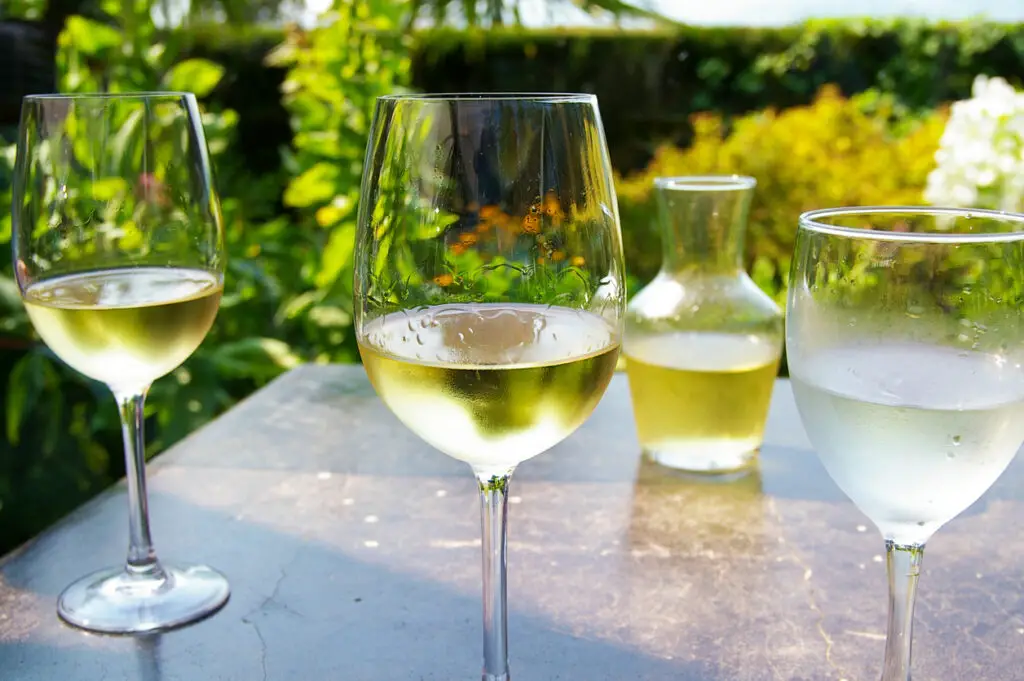As a novice wine drinker, it is common to stick to widely known and easy to pronounce varieties. Look at how many variations of red and white grapes have Pinot and Cabernet in their name. These can all be fantastic choices yet by branching out you can find an array of wines to enjoy and break out of your choice wine monotony. If you love Pinot Grigio then you should consider giving Albarino a try. People sometimes call Albarino the Pinot Grigio of Spain. What makes Albariño vs Pinot Grigio different?
Pinot Grigio is a well-known grape varietal produced around the world while Albarino is primarily grown in Spain. Albarino has more intense aromas and acidity. Albarino grapes are green like most white varietals, however, Pinot Grigio grapes are grey.
These grapes are very similar so let’s dig into both varieties to see how they compare.
The Main Differences Between Albariño vs Pinot Grigio
Do a blind tasting between these two wines and you will be hard-pressed to tell the difference. Both are bright white wines that make a perfectly refreshing summer sipper.
When you examine the color of the wine Albarino will be a pale straw hue but Pinot Grigio will have a hint of pink that is imparted from its skins. Albarino grapes are green while Pinot Grigio grapes are a purple-grey color.
These wines both present citrus aromas. On the nose, Albarino will have more intense aromatics and floral notes than Pinot Grigio. You will have to sniff a little harder to take in components of Pinot Grigio.
Author Note: Citrus, Stone fruit, minerality, and salinity are present in both, but Pinot Grigio will finish with a bit more tart bitterness. Fruit flavors found in these wines include lemon, lime, melon, and grapefruit.
You may find touches of honeysuckle, honey, or beeswax. Pinot Grigio, however, will have more variations in characteristics than Albarino.
One of the biggest differences is the zesty acidity found in Albarino will not be present in Pinot Grigio. Albarino can be likened to Sauvignon Blanc in this aspect.
Albarino is mainly produced in Spain. Italy is known for Pinot Grigio, but the grape is grown in regions around the world in various styles.
Albariño vs Pinot Grigio: Pinot Grigio Basics

Pinot Grigio, also called Pinot Gris, is grown in wine regions around the world. Styles from Italy lead in popularity with their light body and crisp acidity.
Alsace is also known for Pino Gris made in a fuller-bodied version. New world regions often copy the Alsatian style that subtle acid, high alcohol, and a slightly oily texture.
It is a mutated clone of the red grape variety Pinot Noir. It falls into a family tree with Pinot Noir, Pinot Blanc, and Pinot Meunier.
The names Pinot Grigio and Pinot Gris are synonymous, but usually, give you a hint about the style it is made in. Pinot Gris usually describes a fruity wine replicating the French style and Pinot Grigio tells you it is drier like the Italian style.
Gris means grey in French indicative of the color of the grapes. Unlike other white grapes that range in green colors, Pinot Gris is a distinctive purple-grey color.
History of Pinot Grigio
Pinot Gris originated in Burgundy, France. It was taken to Switzerland in the 1300s and gained a following, but it wasn’t until 1961 that it made its way to Northern Italy to be made as a white wine.
The wine gained great success in the regions of Lombardy, Veneto, Friuli, Trentino, and Alto Adige forging the way to become the most popular white wine in Italy. Soon it became the second most popular white wine in the United States.
There are many critics that turn their nose up at Pinot Grigio as being as flat and boring. This reputation comes from mass-produced bottles that were introduced upon its rise in popularity.
On the contrary, there are many dynamic Pinot Grigios to be found around the world. A safe bet is to avoid budget bottles to ensure you’ll have a dynamic experience.
Pinot Grigio Winemaking
Most white wine grapes are a shade of green. Pinot Grigio grapes differ being a grey-mauve color. Their skin is very thin and house juice with a very little color.
Pinot Grigio grapes are flexible and can be made in various styles from light to medium-bodied with crisp acidity to a rich fuller-bodied version. Wines are typically dry, unoaked, and made as a single varietal wine.
These grapes ripen quite rapidly and must be harvested earlier than other varietals. By doing so winemakers ensure the wine maintains adequate acid and fresh fruit characteristics.
Author Note: In order to make white wine from colored grapes, they are pressed and removed from the juice as quickly as possible. The reduction of skin contact with the juice produces wines that are a pale straw color with a hint of pink.
Pinot Grigio grapes that are left to ripen longer will produce a wine that is much more golden in color.
Winemakers typically use stainless steel fermentation tanks to retain a clean fresh profile. There are a few rare exceptions where Pinot grigio is aged in barrels (often chestnut).
It takes around six months to produce Pinot Grigio, making it accessible and lowering the cost for producers.
Different regions tend to bring out key characteristics in the wine. Italian Pinot Grigio is very dry, slightly more acidic, and ends with a bitter almond note.
In France, you will find wines that are a bit oily with a touch of honey from botrytis. American Pinot Grigios typically boast more fruit flavors than the other regions.
Sparkling and Rose Pinot Grigio

Pinot Grigio is used to make frizzante (semi-sparkling) or spumante (sparkling) wines in many Italian regions.
It is sometimes blended with other grapes. Prosecco, for example, allows up to 15 percent of pinot grigio to be added.
A Rose Pinot Grigio is made by maceration, allowing the juice to soak with its purplish-grey skins for 24 to 36 hours. This results in a pale copper-colored Rose.
It is produced in Friuli, Italy where it is called Ramato, and portrays characteristics like white raspberry, sour cherry, leather. It may offer a savory or dried fruit sweetness on its finish.
Flavors of Pinot Grigio
Pinot Grigio varies depending on the style and where it is grown, but in general, you might find these flavors: lime, lemon, green apple, pear, white nectarine, white peach, almond, honeysuckle, honey, saline, clove, ginger, spice
Albariño vs Pinot Grigio: Albarino Basics
Albarino is almost exclusively produced in Spain and Portugal. This bright white wine is rising in awareness and popularity that will soon rival Pinot Grigio and Sauvignon Blanc.
It is believed that Albarino was brought to Iberia by Cluny monks during the 12th century. Other theories claim the grape is indigenous to the region.
This green grape finds its primary home in the region of Rias Baixas that lies on the Northwestern coast of Spain in Galicia. It makes up 90% of the wine produced in the region.
Albarino is also produced in the Spanish regions of Ribeiro and Valdeorras. Here it is most often blended as it traditionally done in most regions until some saw its potential as a single varietal.
It is called Alvarinho in Portugal where it is often cheaper and blended with other white grapes. These come in variable quality and will have tangier fruit and fewer floral notes.
The name Albarino is derived from a Galician term meaning white.
Albarino Winemaking
Albarino quietly crosses some world records. Its vines are believed to be some of the oldest living vines in the world – as old as 300 years — and its grapes are the smallest white wine grape found across the globe.
The tiny grape grows in clustered bunches with very thin skins making it harder to produce. Phenols from the excessive skin contribute to the wine’s bitter taste that reminds you of a fruit rind.
Walk into an Albarino vineyard and you may be a bit taken back. Because the region tends to be wet vines are grown on trellises above your head called Parrales. This allows premium sun exposure and keeps grapes dry protecting them from rot.
Grapes are harvested, pressed, and fermented in stainless steel tanks like many other white wines. Historically Spain has had an affinity for brightly acidic wine and steered away from oak aging.
Top Tip: Some producers conduct a slow maceration before fermentation in order to extract greater complexity, color, and aromas from the skins. Others are experimenting with malolactic fermentation that adds a silky creaminess to the wine.
Flavors of Albarino

This dry white wine has aromas of flowers and citrus that show fruit on the palate and often finishes with a chalky minerality.
Common flavors are: grapefruit, peaches, melon, lemon, lime, dried apricot, pineapple, ginger, mango, honeysuckle
Serving Albarino and Pinot Grigio
These wines are refreshing easy-drinking wines that should be enjoyed young as soon as the bottle is released. They should be served ice cold and served in a standard white wine glass.
The zesty citrus notes and hints of salinity make these wines the perfect match for seafood and shellfish in particular.
Conclusion
There is no doubt that you will enjoy a glass of Albarino or Pinot Grigio. Their bright clean citrus characteristics are as refreshing as a glass of lemonade.
Spanish Albarino offers stronger aromas and more acidity. While Pinot Grigio is softer and more varied in styles.
Green Albarino grapes create wines in a pale straw color. The purple-grey Pinot Grigio grapes impart a pinkish hue in their wines.
Give them both a try and see if you can pick out the subtle differences between these crisp white wines! We hope you enjoyed this article on Albariño vs Pinot Grigio.
To living a full-bodied life,
Wesley

